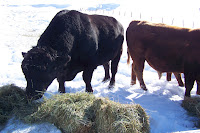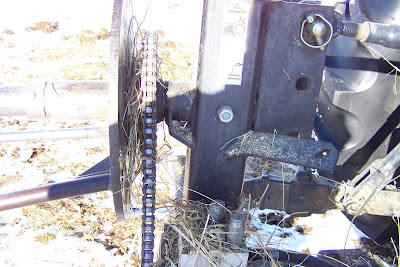 |
| The bulls enjoying their small bales of hay. |
In the early days horsepower was actually measured by the number of horses it took to accomplish the job. Feeding cattle in the winter using horses took all day. One did not just go out and hitch a team to the feed sled and go; there was a lot of prep work to be done first. After the team was caught and grained, they were put into their harnesses and hooked together. The rancher then walked behind them and drove (this means get them to move with use of the reins) them everywhere they would be pulling a feed sled. After the trail has been sufficiently packed, the team was then hooked to the feed sled. The team then took the sled along the packed trail until it was packed even more to allow the sled to slide easily through the snow. It was then that the sled was loaded with hay and driven along the packed trail while the hay was pitched off the sled to the herd. A well trained team would allow the rancher to secure the reins to the sled and feed because the team responded to voice commands. Matt Belton still uses horses. Click on his name if you'd like to see photos of he and his family using their horses to feed and what he has to say.
In this photo from 1943, Pete Stanko is packing the trail past the barn. Note, he is walking behind the team and there is wooden scraper attached to help pack the trail more quickly.
In the Yampa Valley at the very first of the 1900's, cattle were herded to areas where it did not snow so deeply and the cattle could forage for food; areas in the Burns area or over into Moffat County. After ranchers keeping their cattle in the area, hay was stacked loose in piles which looked like loaves of bread. After the development of affordable balers, hay was put up in rectangular bales which had predetermined weights and hay became more efficient to handle. Now there are balers which bale in various size round bales which look like soup cans or large square bales which weigh up to a ton each.The advantage of this new technology is easier storage, less handling which saves time, and it is easier to calculate how much hay is actually being fed.
Equipment used to feed the cattle has changed also. Ranchers in the Yampa Valley use everything from the horses and sleds to 4 wheel drive tractors and grinders which grind up the round bales and lay it out in a measured amount across the top of the clean snow to a combination of old and new; which ever fits their location, traditions, preferences, and finances. Feeding in snow country does have the advantage of allowing the cattle to feed on the clean snow which helps with a lot of complications such as dust.
 |
| The tractor loaded for one trip to the feed yard. |
The spinner on the back has a long spike. We back up to the bale and drive the spike into the center of the bale. The 3 smaller spikes around the outside dig into the bale and help hold it onto the plate while the spinner is unwinding the hay.
This how the spinner fits into the bale.
There are teeth on the back plate which fit between the links of the chain. When the spinner is turned on the chains pull the plate around and makes the hay uncoil from the round bale.
We build snow mounds in the field. The bale carried to the feed yard on the front spike is laid against the mound. We then are able to back into the bale with the spinner and push into the bale until it is securely pressed against the spinner plate. Being able to load the second bale on the spinner in the feed yard save the travel time and fuel of two trips to the stackyard.

Views from the feed yard here at the ranch.






No comments:
Post a Comment